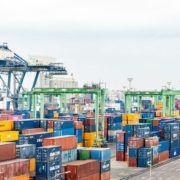Electronic Bills of Lading

Lately there has been a lot of hype about electronic Bills of Lading, which is why we wanted to get back to basics and go over this innovation. So let’s get down to it:
What is the eBL?
The Electronic Bill of Lading (eBL) is an electronic version of the traditional paper-based Bill of Lading used in the shipping industry. The Bill of Lading is a legal document that serves as evidence of the contract of carriage between the shipper and the carrier, proof of ownership, and acts as a receipt for the goods being transported. In the past, it was always a paper document, but with the advancement of technology, it is now possible to issue transmit, and store it electronically.
The eBL has the potential to revolutionize the shipping industry by reducing the time and cost of handling physical documents, eliminating the risk of loss or damage to paper documents, and enabling faster and more secure transactions. However, the adoption of eBLs has been slow due to various legal, technical, and commercial challenges.
What are the challenges?
Despite their incredible potential, there are challenges that need to be addressed before eBLs can become more widely adopted in the shipping industry. One of the main challenges is the lack of standardization in the use of eBLs. There are currently multiple electronic platforms and technologies available for the issuance, transfer, and storage of eBLs, which can create confusion and inefficiencies for users.
To address this challenge, various industry associations and standards bodies, such as the International Chamber of Commerce (ICC) and the International Association of Ports and Harbors (IAPH), have developed guidelines and standards for the use of eBLs. These guidelines aim to promote standardization and interoperability between different electronic platforms and technologies.
A second big challenge is “the difficulty in converting the BL to a digital format without allowing it to be duplicatable (as without proper systems in place it could potentially be duplicated to the infinitum)” – says Jaime Paz from the Ocean Network Express. As the main function of the Bill of Lading is the condition of title of ownership, it is important to ensure that the risk of duplication is minimised or eliminated completely. Today it is possible to have unique digital titles of ownership thanks to blockchain technology, as encryption systems used are strong enough to transfer digital documents without the risk of being duplicated. As an NFT, eBL is not only a digital file, but the registry of the ownership is implicit in it. This way, every change in the eBL process can be registered in a blockchain, in which the information is 100% immutable and 100% auditable.
A final challenge is the resistance to change from stakeholders who are accustomed to traditional paper-based processes. Many shippers, carriers, and banks are still hesitant to adopt eBLs due to concerns about the legal validity, security, and reliability of electronic documents.
To address these concerns, industry stakeholders are working to educate and raise awareness about the benefits of eBLs and to provide training and support for users. For example, the International Group of P&I Clubs has developed a training program for its members on the use of eBLs, and various industry associations have organized workshops and seminars to promote the adoption of eBLs. The DCSA (Digital Container Shipping Association) is also working on towards end-to-end digitalisation of the shipping documentation process – having published the DCSA electronic bill of lading (eBL) standards. The goal with these is to ultimately increase transparency, enhance efficiency, and make compliance easier, therewith eliminating paper from international trade.
A spotlight on Europe
In recent years, there have been several developments in Europe aimed at promoting the use of eBLs. One of the most significant developments is the adoption of the UNCITRAL Model Law on Electronic Transferable Records (MLETR) by the United Nations Commission on International Trade Law (UNCITRAL) in 2017. The MLETR provides a framework for the use of electronic transferable records, including eBLs, and aims to remove legal barriers to their use.
Several European countries have already incorporated the MLETR into their domestic laws, including Denmark, Estonia, Finland, France, Greece, Italy, the Netherlands, Norway, Spain, and Switzerland. These countries have recognized eBLs as legally valid and enforceable documents, and they have established electronic platforms for the issuance, transfer, and storage of eBLs.
For example, the Port of Rotterdam in the Netherlands launched its blockchain-based platform, DELIVER, in 2019, (now Naviporta) which allows users to issue, transfer, and store eBLs. DELIVER is a joint initiative between the port authority, the municipality of Rotterdam, and various industry stakeholders, and it aims to promote the use of eBLs and other digital solutions in the logistics industry.
Additionally, there have been other developments to help the adoption of eBLs in Europe. One of those was championed by the International Group of P&I Clubs, which represents the world’s major marine insurers. They have issued guidelines for the use of eBLs in the insurance industry, which provide a framework for the issuance, transfer, and storage of eBLs, and they aim to ensure that eBLs are accepted and recognized by insurers.
Final thoughts
Despite the challenges, the adoption of eBLs in Europe is gaining momentum, driven by the potential benefits of faster, cheaper, and more secure transactions. The COVID-19 pandemic has also accelerated the shift towards digital solutions in the shipping industry, as it has highlighted the inefficiencies and vulnerabilities of traditional paper-based processes.
In conclusion, the Electronic Bill of Lading is a promising technology that has the potential to revolutionize the shipping industry by reducing costs, increasing efficiency, and improving security. While there are still challenges to be addressed, the adoption of eBLs in Europe is gaining momentum, driven by the efforts of industry stakeholders to promote standardization, raise awareness, and provide training and support for users. As the use of eBLs becomes more widespread, it is expected to bring significant benefits to the global economy by facilitating faster and more secure international trade transactions.
More reading:
- https://www.shippingandfreightresource.com/interoperability-between-different-electronic-bill-of-lading-platforms-becomes-reality/
- https://smartbol.com/electronic-bill-of-lading-a-simple-explanation-of-what-an-electronic-bill-of-lading-is/
- https://www.docusign.com/blog/digital-bill-of-lading-esignature
- https://www.linkedin.com/pulse/future-electronic-bill-lading-ranjan-sinha/?trk=pulse-article_more-articles_related-content-card
- https://dcsa.org/newsroom/resources/beta-releases-of-standards-for-the-booking-process-1-0-and-the-bill-of-lading-2-0/



